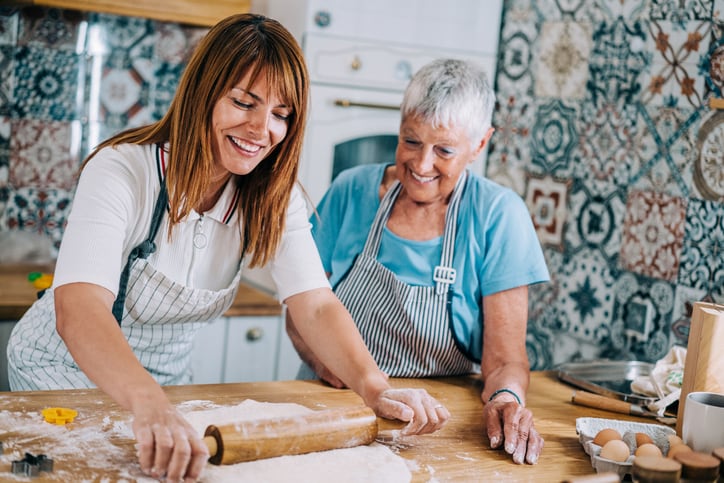As a professional senior caregiver, you’re used to adapting to and navigating difficult or even emergent situations. But throughout this global COVID-19 pandemic, you’ve undoubtedly felt as though you’re swimming in uncharted territory.
That’s understandable given that care workers and caregivers are often the most vulnerable in these moments, according to Janet Kim, communications director at Caring Across Generations, a national initiative to transform the long-term care system. They are often working without benefits like paid vacation or sick time, not to mention training and protection equipment required to protect themselves from catching and spreading the virus, which is sure to make an already stressful situation even worse.
Meanwhile, caregivers continue to grapple with guidance to practice social distancing while caring for a senior.
“In times like these, these problems are even more acute, and caregivers are often on the front lines of being hit hard with little support to turn to,” Kim says. “Staying home sick to protect those they care for often means a huge sacrifice to their own health and financial security in the best of times.”
Experts agree that these circumstances are a case for senior caregivers to be aware of and to address their own needs. Here’s what they recommend doing to bolster your own well-being right now.
1. Prioritize your physical health
“It’s so unbelievably important to prioritize one’s own physical health,” says Kim, adding that taking recommended precautions is key.
You’re already likely quite familiar with the best tools to protect yourself and the seniors in your care against the coronavirus, including the omicron variant:
- Vaccination.
- Masks.
- Limiting social circles as much as possible.
- Frequent hand-washing and sanitizing.
And these are the same strategies you should be continuing to take, according to the Centers for Disease Control and Prevention (CDC).
2. Document and have a backup plan
Coupal recommends taking precautionary measures in case you become ill or need to self-quarantine.
“Caregivers are anxious about continuity of care,” says Amy Coupal, CEO of Ontario Caregiver Organization (OCO). “Having a plan will help to mitigate these feelings.”
Create and document your care plan so your backup team knows exactly what needs to be done should you need to step away from work to self-quarantine, she advises. For instance, you’ll want to provide contact information for your senior’s doctors, clinic, pharmacy, etc. and list the names and doses of medications they need.
“We have to pull together and support and care for another at times like these. We’re all in this together, after all.”
— AMY COUPAL, CEO OF ONTARIO CAREGIVER ORGANIZATION (OCO)
3. Prioritize physical distance and connection through technology
Outside of work, your social distancing practice might cause you to contend with feelings of isolation. Leveraging technology is also a good way to mitigate this, says Coupal.
For that reason, try to reframe “social distancing” as “physical distancing with increased social connection,” Kim advises.
“We have to pull together and support and care for another at times like these,” she says. “We’re all in this together, after all.”
Explore how technology can be used to support someone you care for when you can’t be in the same place at the same time, says Coupal. For ideas, check out the OCO’s tip sheet.
4. Step up your self-care
You want to stay informed, but it’s also normal to feel increasingly overwhelmed by rapidly changing information. If watching, reading or listening to the news is causing anxiety and distress, reduce your exposure and seek updates from trusted sources once or twice a day, advises Coupal. Consider checking out sites such as the CDC, the National Institutes of Health (NIH) and your local Department of Public Health to start.
“As much as possible, keep a regular routine,” she says.
That routine should include self-care moves like using a meditation app, doing breathing exercises, taking a walk outdoors (while being sure to maintain physical distance from others) or working out when possible.
And remember to prioritize connection with friends and loved ones, as well as a mental health care professional.
“Come up with a call list of friends you can talk to while you’re dealing with all of this for a little relief,” says Kim. “See if there are remote — text or video — therapy resources in your area, such as BetterHelp or TalkSpace.”
5. Channel frustration into action
This crisis is shedding light on the challenges caregivers experience every day because of inflexible, family-unfriendly work policies and a fragmented, outdated and profit-centered care system, which we are all experiencing the cracks of now, Kim says.
By joining advocacy groups, you can connect with other caregivers who want to demand better and who could serve as a valuable support network during this tough time. In addition to Caring Across Generations, check out Caregiver Action Network (CAN) and other recommendations from the American Society on Aging.

